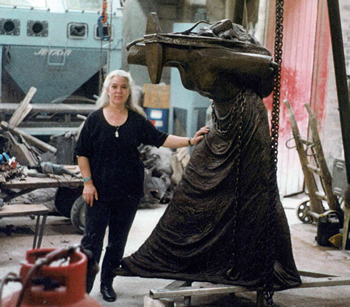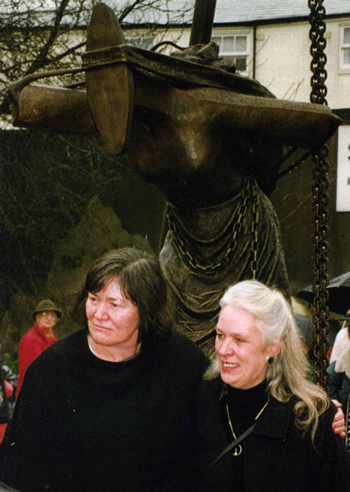“WOMEN'S WORK” 1996 - 1998

This four metre high bronze sculpture by Rose Garrard of a female figure beside a pit-head gantry, commemorates the impoverished women working in the 19th century coal and iron industries of the Black Country. It can be seen in Bilston High Street close to the site of a ‘fold’, a cluster of small hovels where families lived and the women repetitively forged tiny items such as nails, chain links and pulleys, selling them to merchants to survive. These items have been fused into the clothing of this metamorphic figure, whose head is the small anvil and her forearms the tongs used for holding the hot metal. Her feet are flat irons, while the back of her skirt is composed of stacked cooking pots. Local women were later employed in nearby factories making cast iron cooking pots and flat irons as well as in large laundries where they put the irons to use. The figure is stooped over to support her burden of coal, the constant position of a ‘pit-bank wench’ paid to work bowed down all day to reclaim any usable lumps of coal from the slag heaps at the pit head.

This sculpture by Rose forms the central feature in the Black Country Sculpture Route and in May 1998 was unveiled by Clare Short M.P., Minister for Overseas Development with a special responsibility for the eradication of poverty. In the crowd during this event a group of three elderly local women were in tears because they couldn’t believe that a statue had been made in memory of the hard lives of their impoverished grandmothers. The sculpture was commissioned by the Wolverhampton Metropolitan Borough Council and sponsored by Tarmac.
 ;
;
By the morning of the public unveiling, a considerable time after the sculpture had been completed, there was tension in the air as the Council still hadn't paid Rose for her work. She now threatened to reveal this to the assembled press, but then a senior Council figure pressed a letter into her hand that guaranteed her payment within two weeks. After more than three weeks had passed without payment, Rose wrote to Clare Short to ask if she could help, explaining that as the sculptor of 'Women's Work' and the only woman working on the project, ironically Rose was the only one not to have been paid. Her cheque arrived a few days later.